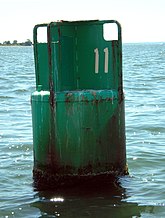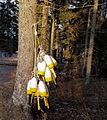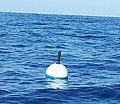Buoy



A buoy (/bɔɪ/, /ˈbuːi/)[1] is a floating device that can have many purposes. It can be anchored (stationary) or allowed to drift with ocean currents.
Types[]
[]
- Race course marker buoy – Buoy racing is the most prevalent form of yacht racing and power boat racing. The buoys are used to delimit the race course and must be passed to a specified side. Course marker buoys are also used in underwater orienteering competitions.
- Emergency wreck buoy – An emergency wreck buoy provides a clear and unambiguous means of marking new wrecks. This buoy is used as a temporary response, typically for the first 24–72 hours. This buoy is coloured in an equal number of blue and yellow vertical stripes and is fitted with an alternating blue and yellow flashing light. This has come about due to the collisions which occurred in the Dover Strait in 2002 when vessels struck the new wreck of the MV Tricolor.[2]
- Ice marking buoys – used for marking ice holes in frozen lakes and rivers, so that snowmobiles do not drive over the holes.
- Large Navigational Buoy (LNB or Lanby buoy) is an automatic buoy over 10 m high equipped with a powerful light monitored electronically as a replacement for lightships.[3] An LNB may be marked on charts as a "Superbuoy."[4]
- Lateral marker buoy
- Safe water mark or Fairway Buoy – a navigational buoy which marks the entrance to a channel or a nearby landfall
- Sea mark – aids pilotage by marking a maritime channel, hazard and administrative area to allow boats and ships to navigate safely. Some navigational buoys are fitted with a bell or gong, which sounds when waves move the buoy
- Wreck buoy – a buoy to mark a wrecked ship to warn other ships to keep away because of unseen hazards.
- Light buoy - a buoy to use as demarcation at night.
Marker buoys[]
Buoys are often used to mark the position of an underwater object. They may be temporary or permanent.
- Lobster trap buoys – brightly colored buoys used for the marking of lobster trap locations so the person lobster fishing can find their lobster traps. Each lobster fisher has its own colour markings or registration numbers so they know which ones are theirs. They are only allowed to haul their own traps and must display their buoy colour or license number on their boat so law enforcement officials know what they should be hauling. The buoys are brightly coloured with highly visible numbers so they can be seen under conditions when there is poor visibility like rain, fog, sea smoke, etc.[5][6]
Diving[]
Several types of marker buoy may be used by divers.
- Decompression buoy – deployed by submerged scuba divers to mark their position underwater whilst doing decompression stops
- Shot buoy – used to mark dive sites for the boat safety cover of scuba divers so that the divers can descend to the dive site more easily in conditions of low visibility or tidal currents and more safely do decompression stops on their ascent.
- Surface marker buoy – taken on dives by scuba divers to mark their position underwater[7]
- Dive site demarcation buoy – Buoy used as an indication that divers are working within the demarcated area. It is intended to notify passing vessels to stay out of the demarcated area.
Rescue[]
- Lifebuoy – used as a life saving buoy designed to be thrown to a person in the water to provide buoyancy. Usually has a connecting line allowing the casualty to be pulled to the rescuer
- Self-locating datum marker buoy (SLDMB) – A 70% scale Coastal Ocean Dynamics Experiment (CODE)/Davis-style oceanographic surface drifter with drogue vanes between 30 and 100 cm deep.[8] This particular surface drifter is designed specifically for deployment from a U.S. Coast Guard vessel or airframe for search and rescue. Since the SLDMB has a very small surface area above the ocean surface and a high underwater surface area, there is very little leeway in response to the direct forcing of winds and waves.[9]
- Submarine rescue buoy – used for release in case of emergencies or for communication
Research[]
- Profiling buoy – specialized models which adjust buoyancy so that they will sink at a controlled rate to 2,000 metres below the surface while measuring sea temperatures and salinity. After a time, typically 10 days, the buoy returns to the surface, transmits its data via satellite, and then sinks again.[10] See Argo (oceanography).
- Tsunami buoys – anchored buoys that can detect sudden changes in undersea water pressure are used as part of tsunami warning systems in the Pacific Tsunami Warning Center and Indian Oceans.
- – used to measure the movement of the water surface as a wave train. The wave train is analysed to determine statistics like the significant wave height and period, and wave direction.
- Weather buoys – equipped to measure weather parameters such as air temperature, barometric pressure, wind speed, and direction and to report these data via satellite radio links such as the purpose-built Argos System or commercial satellite phone networks to meteorological centres for use in forecasting and climate study. May be anchored (moored buoys) or allowed to drift (drifting buoys) in the open ocean currents. Position is calculated by the satellite. Weather buoys are sometimes referred to as ODAS buoys or Ocean Data Acquisition Systems[11] and may be marked on charts as "Superbuoys."[4]
Mooring[]
- Mooring buoys – used to keep one end of a mooring cable or chain on the water's surface so that ships or boats can tie on to it. Many marinas mark these with a number and assign it to a particular vessel, or rent it out to transient vessels.
- Tripping buoys – used to keep one end of a 'tripping line' on the water's surface so that a stuck anchor can more easily be freed
Military[]
- Marker buoys – used in naval warfare, particularly anti-submarine warfare, is a light-emitting or smoke-emitting, or both, marker using some kind of pyrotechnic to provide the flare and smoke. It is commonly a 3-inch (76 mm) diameter device about 20 inches (500 mm) long that is set off by contact with seawater and floats on the surface. Some markers extinguish after a set period and others are made to sink.
- Sonobuoy – used by anti-submarine warfare aircraft to detect submarines by SONAR
- Target buoy – used to simulate target (like small boat) in live fire exercise by naval and coastal forces, usually targeted by weapons (medium size) like HMG's, rapid fire cannons (20 or so mm), autocannons (bigger ones up to 40 and 57mm) and also anti-tank rockets.
Specific forms[]
- DAN buoy – has several meanings:
- A large maritime navigational aid providing a platform for light and radio beacons
- A lifebuoy with flags used on yachts and smaller pleasure craft
- A temporary marker buoy used during Danish seine fishing to mark the anchor position of a net.
- A temporary marker buoy set by danlayers during minesweeping operations to indicate the boundaries of swept paths, swept areas, known hazards, and other locations or reference points.
- A temporary marker buoy set to mark a man overboard position.
- Spar buoy – a tall, thin buoy that floats upright in the water, e.g. R/P FLIP.
Other[]
- The space buoy is a common element in science fiction that refers to a stationary object in outer space that provides navigation data or warnings about that particular area.[citation needed]
- Mail buoy – an imaginary buoy used as a prank in the US Navy[12]
Other uses[]
- The word "buoyed" can also be used figuratively. For example, a person can buoy up ('lift up') someone's spirits by providing help and empathy.[13]
- Buoys are used in some wave power systems to generate electrical power.[14]
- George A. Stephen, founder of Weber-Stephen Products Co., invented the kettle grill by cutting a metal buoy in half and fashioning a dome shaped grill with a rounded lid.[15]
Gallery[]
Several different buoys at a storage depot.
A buoy used as turn marker for sailing races.

Old iron buoys, most likely for mooring.

Children playing on a buoy in the Volga

A buoy beached at Sebastian Inlet State Park.
Emergency buoy of the Swedish submarine Nordkaparen

Gas buoy stranded on land after 1915 Galveston Hurricane, near Texas City, Texas

Starboard lateral Buoy (Lateral mark - Region B - IALA ) as Channel Marker Buoy at "Río de la Plata" river, Buenos Aires, Argentina

Tsunami buoy before deployment in Andaman Sea

Lobster buoys hanging on a tree, Sprucehead Island, Maine, United States

Buoys in dry storage, Homer, Alaska

Drifting Buoy fitted with a Barometer

Buoy undergoing repair

Ring life buoy with a light on a cruise ship

A buoy off the coast of Whitby, North Yorkshire
See also[]
References[]
- ^ buoy in the American Heritage Dictionary
- ^ "Archived copy". Archived from the original on 2014-07-02. Retrieved 2014-05-26.CS1 maint: archived copy as title (link)
- ^ "Large Navigational Buoys (LNB)". United States Coast Guard. Retrieved Jul 6, 2015.
- ^ Jump up to: a b National Oceanic and Atmospheric Administration (2013). US Chart No. 1. Silver Spring: NOAA. p. 89.
- ^ Cobb, John N., "The Lobster Fishery of Maine", Bulletin of the United States Fish Commission, Vol. 19, Pages 241–265, 1899; from Project Gutenberg
- ^ Taft, Hank; Taft, Jan, A Cruising Guide to the Maine Coast and the Maine Coast Guides for Small Boats, Peaks Island, Maine : Diamond Pass Publishing, 5th Edition, 2009. Cf. Chapter: "BUOY, OH BUOY" Archived 2008-11-18 at the Wayback Machine, and Chapter: "Fisherman, Lobsterboats, and Working Harbors" Archived 2012-03-20 at the Wayback Machine
- ^ Davies, D (1998). "Diver location devices". Journal of the South Pacific Underwater Medicine Society. 28 (3). Archived from the original on 2009-05-19. Retrieved 2013-04-16.
- ^ [METOCEAN. (2008). METOCEAN SLDMB: Operating & Maintenance Manual (Version 3.0 ed.) Retrieved from http://www.metocean.com.
- ^ [Bang, I., Mooers, C. N. K., Haus, B., Turner, C., Lewandowski, M. (2007). Technical Report: Surface Drifter Advection and Dispersion in the Florida Current Between Key West and Jacksonville, Florida. Technical Report.].
- ^ Kery, SM (1989). "Diving in support of buoy engineering: The RTEAM project". In: Lang, MA; Jaap, WC (ed). Diving for Science…1989. Proceedings of the American Academy of Underwater Sciences annual scientific diving symposium 28 September – 1 October 1989 Wood Hole Oceanographic Institution, Woods Hole, Massachusetts, USA. Archived from the original on 2013-06-21. Retrieved 2013-04-16.
- ^ IALA (2008). "International Dictionary of Marine Aids to Navigation – ODAS buoy". Retrieved 10 December 2016.
- ^ "Pranks: Some old, some new". USS RICH. USS RICH Association.
- ^ "buoy". Oxford English Dictionary. Vol II (2nd ed.). Oxford University Press. 1989. p. 661.
|volume=has extra text (help) verb, sense 3. - ^ Buoy System Harnesses Wave Energy - ABC News
- ^ George Stephen, Company Founder and Inventor of the Weber Kettle Grill Archived June 23, 2007, at the Wayback Machine
External links[]
| Look up buoy in Wiktionary, the free dictionary. |
| Wikisource has the text of the 1911 Encyclopædia Britannica article "Buoy". |
| Wikimedia Commons has media related to Buoys. |
- Nautical terminology
- Navigation
- Buoyage
- Maritime safety















